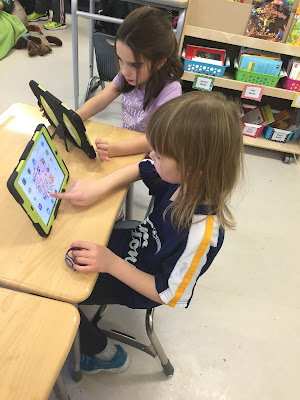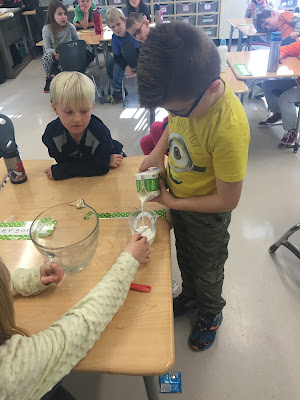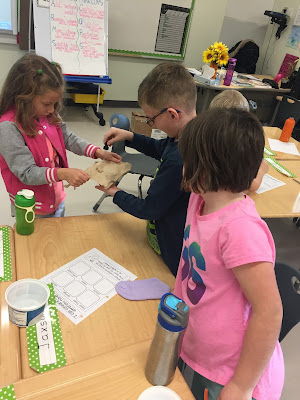We filled up our Brownie Point pan! As a reward we had free time on the iPad's!
Tuesday, November 24, 2015
Brownie Points
Matter
Last week we continued our Matter unit.
First, we learned about matter changing
form. Can a liquid become a gas? Can a solid become a liquid? To answer these
questions we took a piece of ice (solid) and watched it melt into water
(liquid). Then, we put the water into a kettle and saw it turn into steam (gas).
We learned that temperature sometimes causes matter to change form.
The next day we made ice cream! We watched the cream (liquid) turn into solid ice cream!
Then, we learned about sinking and floating. The students were put into groups. Each group got a large bowl of water and various objects. They had to predict what objects would sink and what objects would float. Throughout these experiments we learned that the weight of a solid object does NOT tell us if it floats. The amount of "empty space" in a object is what matters. Solid objects with more empty space or air in them float, and solid objects with less air space sink.
Then, we learned about objects dissolving. First, the students were put into groups. Each group was given plastic cups filled with water and various objects. They had to predict what would happen to each object when it was added to the water. Will these solids dissolve or not?
On Thursday, we learned about solids that absorb liquids. The students were given different types of solids (cloth, paper, paper towel, Popsicle stick). They used eye-droppers to see what objects would absorb water! We learned that some things absorb and hold a lot of water. We also learned that sometimes you can get the water back if you squeeze the cloth or sponge.
If you are interested in purchasing any of these handouts you can purchase them on Teachers Pay Teachers.
https://www.teacherspayteachers.com/Product/Learning-About-the-States-of-Matter-Engaging-Materials-for-Young-Scientists-2096706
https://www.teacherspayteachers.com/Store/First-Grade-Garden/Grade-Level/Second/Search:science
Our Classroom & School Community
Last week we continued learning about Our Classroom & School Community.
First, we discussed why school maps are important. Why is it important to have a school map in each classroom? We brainstormed a variety of answers such as...
1. So a substitute teacher knows where to go.
2. So everyone knows where the exits are if there was an emergency.
3. So new students/visitors know how to get to where they need to be.
Then, we discussed the responsibilities of people in the school. We brainstormed a list of people's names and the jobs they do. We discussed the different responsibilities/jobs a principal, teacher, librarian, custodian, and admin assistant has. Then, we discussed what responsibilities students have. What would happen if everyone in the school didn't do their job?
Labels:
Communities
,
Health
,
November.
,
Social Studies
Tuesday, November 17, 2015
Matter
In November, we are learning all about matter!
So far we have learned about the three states of matter. First, we learned about the three states of matter by observing three bags. The first bag was filled with marbles, the second bag was filled with water and the third bag was filled with air. The students worked in groups to describe each bag. Each group came to the conclusion that the marbles were hard, the water was jiggly, and the air bag looked empty. After, we discussed the difference between solids, liquids and gases. We can feel the hard shape of a solid, we can pour a liquid and air is a gas. We came to the conclusion that everything in the world is matter. To finish off the lesson the students drew an example of a solid, liquid and a gas.

Then, we learned about atoms and molecules. The students used magnifying glasses to look at the properties of objects around the classroom. What properties could they see with their magnifying glass that they couldn't see before? We could see that all of the objects in the classroom are made up of smaller and smaller bits. All matter is made up of tiny particles that we can't always see, even with a magnifying glass. These are called atoms, and even atoms are made up of smaller bits called molecules. There are different molecules and atoms in every object. The molecules in wood are different from the ones in water. Then, the students acted like atoms/molecules. First, the students stood grouped together. They could see that when they are "solidly" packed that there is no room to move. In solids, the atoms and their molecules are tightly packed together with very little room to move. There are lots of atoms in a solid object and they move as one.
Then, a few students went back to their desks. The students left over had more room to move around. This is the way atoms and molecules work in a liquid. If liquid is poured, the atoms can "flow" to another place.
Then, a few more students stepped away. The students left over had LOTS of room to move around freely. With gases, there are fewer atoms and molecules so they are constantly moving around.
Two weeks ago, we focused on solids. We reviewed that solids have a shape of their own. Then, we learned a poem:
A solid is a solid,
And it always takes up space.
It has some weight and has a shape,
A ball, a book, your face.
You are a solid,
And so is your chair.
Just look in your classroom--
Wow! They're everywhere!
We discussed what taking up space means, then we looked around the classroom to see what objects take up space.
Then, we learned about liquids. First, we learned the following poem:
A liquid moves smoothly.
We say that it flows.
From one place to another.
How quickly it goes!
We know that most liquids
Are easy to see.
With no shape of their own,
They're not like you and me.
We learned that a liquid does not have a definite shape. The amount and weight of a liquid stays the same. The students explored this idea by looking at different glass jars and vases. Some were tall and some were short; some were thin and some were wide. They measured the liquid in one container, then poured it into a different container. What happened to the shape? Did the weight change? Then,we discussed if all liquids flow in the same way. We recognized that some liquids are more dense and pour slowly. After this experiment the students drew a picture of a liquid.
Last week, we learned about gases. First, we learned the following poem:
Air is a gas.
We can't see it, that's true;
but often we feel it
In things that we do.
It keeps up a kite.
Air fills up a bubble.
Without it to breathe,
We would be in BIG trouble!
Then, the students were given baggies. They blew up their baggie until it was filled with air. We discussed that air is a gas. It takes up space, and sometimes we can feel it. After this experiment the students drew a picture of a gas.

Then we compared liquids and solids. What is the same? What is different?
If you are interested in purchasing any of these handouts you can purchase them on Teachers Pay Teachers.
https://www.teacherspayteachers.com/Product/Learning-About-the-States-of-Matter-Engaging-Materials-for-Young-Scientists-2096706
https://www.teacherspayteachers.com/Store/First-Grade-Garden/Grade-Level/Second/Search:science
Subscribe to:
Posts
(
Atom
)
































































